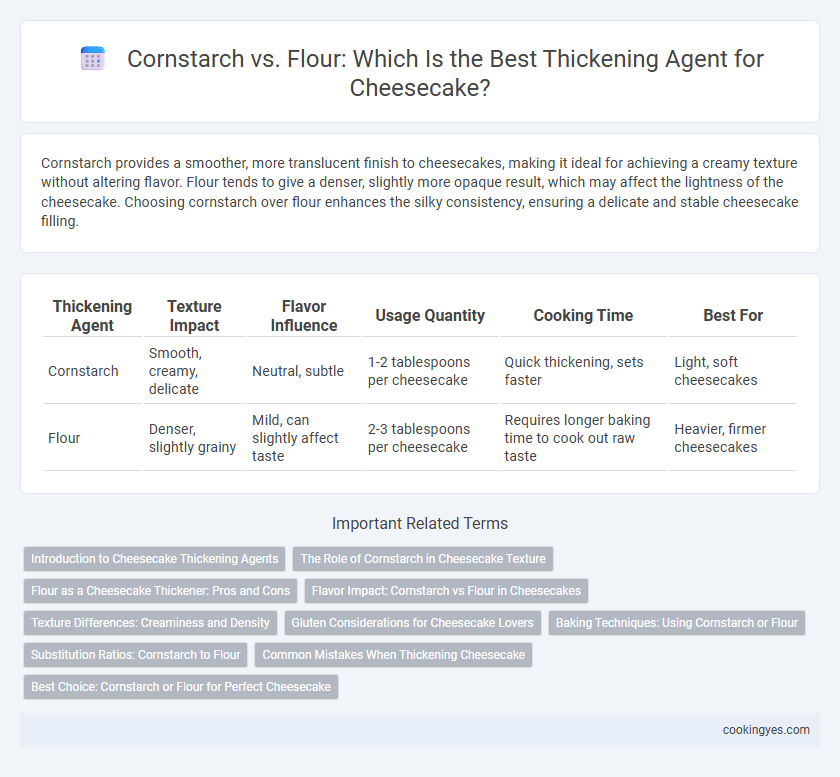Cornstarch provides a smoother, more translucent finish to cheesecakes, making it ideal for achieving a creamy texture without altering flavor. Flour tends to give a denser, slightly more opaque result, which may affect the lightness of the cheesecake. Choosing cornstarch over flour enhances the silky consistency, ensuring a delicate and stable cheesecake filling.
Table of Comparison
| Thickening Agent | Texture Impact | Flavor Influence | Usage Quantity | Cooking Time | Best For |
|---|---|---|---|---|---|
| Cornstarch | Smooth, creamy, delicate | Neutral, subtle | 1-2 tablespoons per cheesecake | Quick thickening, sets faster | Light, soft cheesecakes |
| Flour | Denser, slightly grainy | Mild, can slightly affect taste | 2-3 tablespoons per cheesecake | Requires longer baking time to cook out raw taste | Heavier, firmer cheesecakes |
Introduction to Cheesecake Thickening Agents
Cornstarch and flour are common thickening agents used in cheesecake recipes to achieve the desired creamy texture and structural stability. Cornstarch provides a smoother, silkier finish by preventing curdling and creating a tender crumb, while flour offers more rigidity but can yield a denser texture. Choosing the right thickener depends on the cheesecake style, with cornstarch favored for custard-like cheesecakes and flour for firmer, more cake-like varieties.
The Role of Cornstarch in Cheesecake Texture
Cornstarch acts as an effective thickening agent in cheesecakes, creating a smooth and creamy texture by stabilizing the filling and preventing it from cracking during baking. Unlike flour, cornstarch has a neutral flavor and a finer consistency, which allows for a more delicate mouthfeel and helps maintain moisture. The use of cornstarch contributes to a denser, silkier cheesecake, enhancing the overall eating experience with a tender consistency.
Flour as a Cheesecake Thickener: Pros and Cons
Flour as a cheesecake thickener offers a denser and firmer texture, providing stability that helps prevent cracking during baking. Its use can result in a slightly heavier crumb compared to cornstarch, which may affect the delicate creaminess desired in classic cheesecakes. However, flour is more heat-stable and less prone to causing a gummy consistency, making it suitable for recipes where a robust structure is prioritized.
Flavor Impact: Cornstarch vs Flour in Cheesecakes
Cornstarch provides a cleaner, more neutral flavor that allows the creamy richness of cheesecake to shine without altering its taste, while flour can introduce a slightly pasty or doughy note that may detract from the delicate flavor profile. The use of cornstarch results in a smoother texture and a lighter mouthfeel, enhancing the overall sensory experience. In contrast, flour thickening may yield a denser texture, subtly impacting the intended flavor balance of traditional cheesecakes.
Texture Differences: Creaminess and Density
Cornstarch creates a smoother, creamier texture in cheesecake by providing a delicate, gel-like consistency that stabilizes the filling without adding density. Flour tends to produce a denser, slightly heavier cheesecake due to its gluten content, which can give a more cake-like structure rather than a creamy mouthfeel. Choosing cornstarch enhances silkiness and lightness, while flour results in a firmer, more substantial texture.
Gluten Considerations for Cheesecake Lovers
Cornstarch is often preferred over flour as a thickening agent in cheesecakes due to its gluten-free nature, making it ideal for individuals with gluten sensitivities or celiac disease. Flour contains gluten, which can alter the texture of the cheesecake by making it denser or chewier, whereas cornstarch provides a smoother, creamier consistency. Choosing cornstarch helps maintain the desired lightness and enhances the overall flavor without risking gluten contamination.
Baking Techniques: Using Cornstarch or Flour
Cornstarch provides a smoother, silkier texture in cheesecakes by creating a translucent, tender crumb due to its higher thickening power and ability to prevent graininess. Flour, containing gluten, can result in a denser, firmer cheesecake with a slightly cakier structure, which may alter the delicate balance of creaminess. Choosing cornstarch enhances the creaminess and stability during baking, while flour offers more structure but risks a less creamy outcome.
Substitution Ratios: Cornstarch to Flour
Cornstarch and flour differ in thickening power for cheesecakes, with cornstarch being approximately twice as potent. The typical substitution ratio is 1 tablespoon of cornstarch for 2 tablespoons of flour to achieve similar consistency. Using cornstarch results in a smoother texture and clearer appearance compared to the slightly denser outcome from flour.
Common Mistakes When Thickening Cheesecake
Using flour as a thickening agent in cheesecake often leads to a denser texture due to its gluten content, which can create an undesirably heavy crust and filling. Cornstarch, by contrast, provides a smoother, creamier consistency without altering the flavor or structure, but overuse can cause a gummy texture. Common mistakes include adding too much thickener, failing to fully incorporate it into the batter, and mistiming its addition, all of which jeopardize the delicate balance of a perfect cheesecake.
Best Choice: Cornstarch or Flour for Perfect Cheesecake
Cornstarch is the best choice for thickening cheesecake as it creates a smooth, creamy texture without imparting any floury taste, ensuring a perfect consistency. Flour can make the cheesecake denser and sometimes slightly gummy, which may detract from the desired lightness. Using about 1 to 2 tablespoons of cornstarch per recipe stabilizes the filling while maintaining a delicate, silky finish.
Cornstarch vs Flour for cheesecake thickening agent Infographic

 cookingyes.com
cookingyes.com